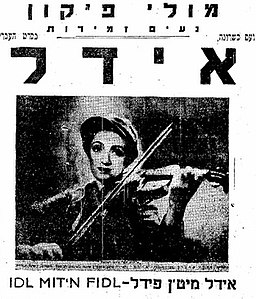Yidl mitn Fidl
| Movie | |
|---|---|
| German title | Jidl with the fiddle |
| Original title | Yidl mitn Fidl, אידל מיטן פֿידל |
| Country of production | USA , Poland |
| original language | Yiddish |
| Publishing year | 1936 |
| length | 92 minutes |
| Rod | |
| Director |
Joseph Green Jan Nowina-Przybylski |
| script | Joseph Green Konrad Tom (book) |
| production | Joseph Green |
| music |
Abraham Ellstein , lyrics by Itzik Manger |
| camera | Jakob Jonilowicz |
| occupation | |
| |
Yidl mitn Fidl ( Yiddish אידל מיטן פֿידל, [jid'l mit'n fid'l], Polish Judel gra na skrzypcach , English title Yiddle with His Fiddle , German Jidl with the fiddle ) is a film shot in Kazimierz Dolny and Warsaw in 1936 American-Polish Yiddish film with the American-Jewish actress Molly Picon in a trouser role in the lead role. The musical comedy was produced by actor Joseph Green, who also co-directed with Jan Nowina-Przybylski and wrote the screenplay based on a story by Konrad Tom. The music is by Abraham Ellstein , the lyrics by Itzik Manger .
action
The destitute widower Arie and his daughter Itke are chased out of their house and have to hire themselves out as street musicians. For safety reasons, the daughter dresses up as a boy Jidl. On the way they meet two musicians, Isaak and Froim, with whom they move on together. Jidl falls in love with Froim, who also plays the violin, who she thinks has fallen in love with Teibele, an unhappy bride at whose wedding the musicians play and who helps Jidl to escape. Teibele's talent as a singer is discovered in Warsaw, but she disappears before her first appearance. In her place Jidl appears involuntarily, who becomes famous and at the end of the mistaken comedy after years on the crossing to America finds her lost lover Froim.
The film takes a critical look at various anti-Semitic stereotypes . The image of the effeminate Jewish man , which was widespread among anti-Semites at the time, especially propagated by Otto Weininger , is caricatured by the woman disguised as a little Jew (Jidl) and refuted in the portrayal of Froim as the epitome of masculinity, as are prejudices that Jews do not drink alcohol, cannot swim, are not interested in agriculture and shy away from settling down.
background
The film, which cost around US $ 50,000, was released in September 1936 in Poland at the end of the year on Broadway in New York . It was the first internationally successful Yiddish film and was shown worldwide. The film received consistently very good reviews in the Yiddish press, while the English-language American newspapers were less enthusiastic. The film was even shown in Nazi Germany , where Jewish audiences were no longer allowed to visit conventional cinemas: The Berlin premiere took place on May 2, 1938 at the Jewish Cultural Association ; after that the film was shown in various major German cities. In 1956 , a new English dubbed edition, Castles in the Sky , was performed for a short while in New York.
literature
- Sylvia Paskin (Ed.): When Joseph Met Molly: A Reader on Yiddish Film . Five Leaves Publications, Nottingham 1999 ISBN 978-0-907123-92-7 (English)
Web links
- Yiddle with his fiddle in the Internet Movie Database (English)
- YIDL MITN FIDL ( Memento from February 19, 2007 in the Internet Archive ). Fritz Bauer Institute, Cinematography of the Holocaust
- Steven Lasky: Movie Review: "Yidl mitn Fidl" (1936) . Museum of Family History
- David Lugowski: “Pintele” Queer: The Performance of Jewish Male Heterosexuality in Yiddish American Cinema of the Great Depression . In: Sean Griffin (Ed.): Hetero: Queering Representations of Straightness . State University of New York Press, Albany 2009, pp. 53–70 ISBN 978-1-4384-2617-4 (English)
- Chantal Catherine Michel: The Yiddish Cinema in Poland . The Yiddish Cinema
- Sarah Schulman: Yidl Mitn Fidl. Yiddish fictional cinema . Jump Cut, A Review of Contemporary Media, no. 31, March 1986, p. 42 (English)
- Eve Sicular: “A yingl with a yingl hot epes a tam”: The Celluloid Closet of Yiddish Film . In: Jewish folklore and ethnology review , Volume 16, 1994, pp. 40–45 (English)
- "Idl mit'n Fidl": Film premiere in the Berliner Kulturbund , CV newspaper , May 5, 1938.
-
Extracts :
- YIVO: Audio: Music from the film Yidl mitn fidl Text: Itsik Manger, Music: Abe Ellstein. Singing: Molly Picon and Simcha Fostel, orchestra conducted by Abe Ellstein
Individual evidence
- ↑ Mendele ( Memento of April 8, 2014 in the Internet Archive )
- ^ J. Hoberman: Cinema . In: The YIVO Encyclopedia of Jews in Eastern Europe , online edition, accessed June 10, 2011
- ^ Warren Hoffman: The passing game: queering Jewish American culture . Syracuse University Press, New York 2009, pp. 75–83 ISBN 0-8156-3202-9 (English)
- ↑ Michele Aaron: Cinema's Queer Jews: Jewishness and masculinity in Yiddish Cinema . In: Phil Powrie, Ann Davies, Bruce Babington (Eds.): The trouble with men: masculinities in European and Hollywood cinema . Wallflower Press, London 2004, pp. 90–99 ISBN 1-904764-08-8 (English)
- ↑ Jim Hoberman: Bridge of Light. Yiddish Film Between Two Worlds . Temple University Press, Philadelphia, Penn. 1995, pp. 235–243 ISBN 1-56639-404-X, extracts online (English)
- ↑ Hoberman, p. 254.
- ↑ Ernst Offermanns, The German Jews and the feature film of the Nazi era , Peter Lang, 2008. p. 43.
- ↑ Hoberman, p. 340.

